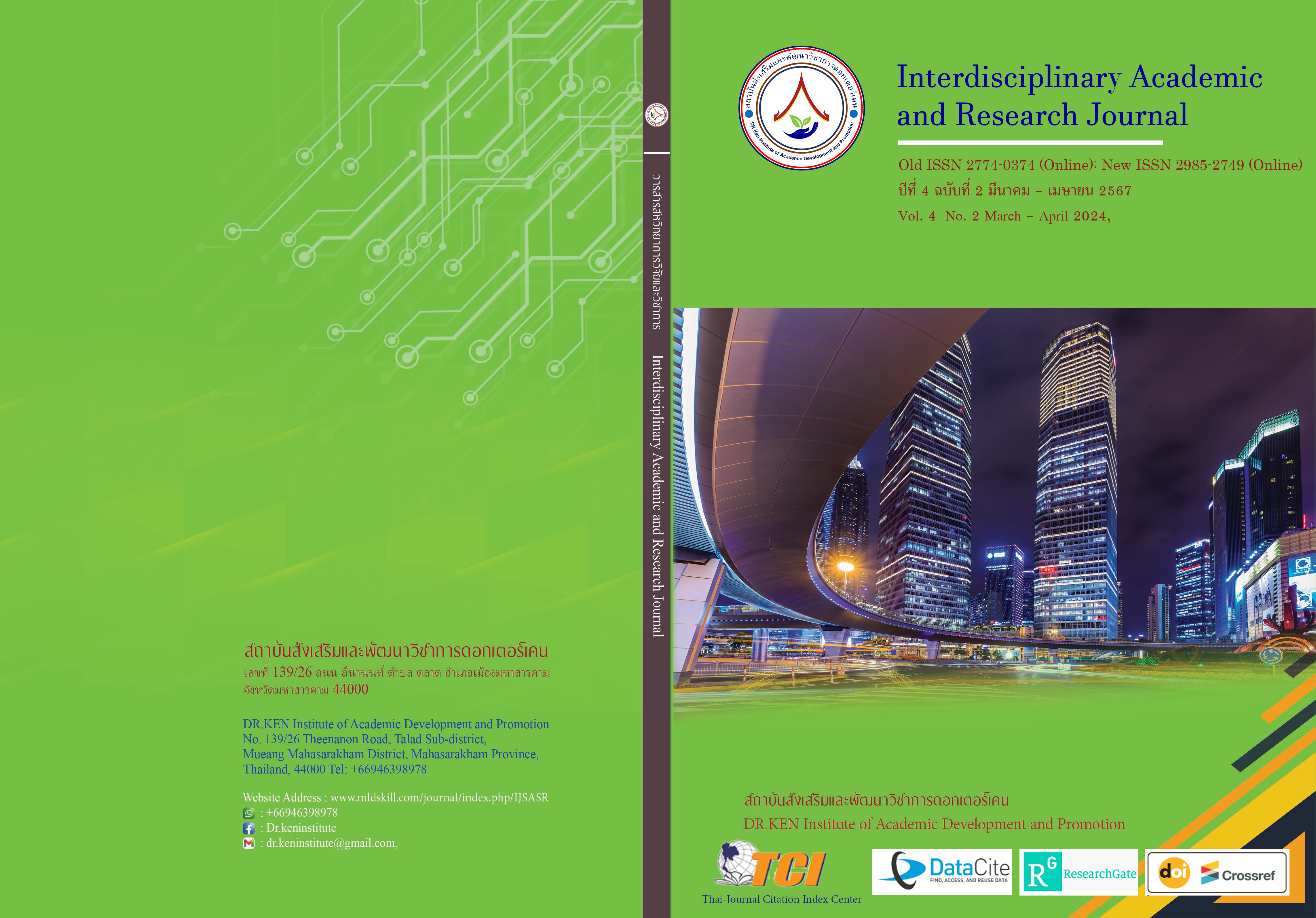The Effects of Activities Management According to the CPA Approach on Learning Achievement and Mathematics Representation on Fraction of Grade 3 Students at The Demonstration School of Valaya Alongkorn Rajabhat University under the Royal Patronage in Pathum Thani Province
DOI:
https://doi.org/10.60027/iarj.2024.275227Keywords:
CPA Approach; , Learning Achievement; , Mathematics Representation; , Primary EducationAbstract
Background and Aims: Mathematical thinking processes help people apply mathematical knowledge to solve various problems effectively, therefore mathematics education needs to be continually developed. The purposes of this research were to 1) study the relationship between mathematics learning achievement and mathematics representation of grade 3 students in the group learning with CPA approach and 2) compare the mathematics learning achievement and mathematics representation of grade 3 students between the group learning with CPA approach and the group learning with conventional mathematics learning activities.
Methodology: Quasi-experimental research used 2 sample groups consisting of 60 grade 3 students of The Demonstration School of Valaya Alongkorn Rajabhat University under the Royal Patronage in Pathum Thani Province during the first semester of the academic year 2023. Two classrooms, each with 30 students, were obtained by cluster random sampling. The employed research instruments consisted of 1) mathematics learning management plans on Fractions by using activities management according to the CPA approach 2) mathematics learning management plans on Fractions by using conventional mathematics learning activities 3) a mathematics learning achievement test and 4) an evaluation form for mathematics representation. Statistics employed for data analysis were the mean, standard deviation, Pearson’s correlation coefficient, and MANOVA test.
Results: found that 1) the relationship between mathematics learning achievement and mathematics representation of grade 3 students learning with the CPA approach has a positive relationship with high correlation (r= 0.667, p<.01) counterpart ability at the .01 level with the percentage of covariation is 44.489. and 2) Mathematics learning achievement and mathematics representation of grade 3 students learning with the CPA approach was significantly higher than the group learning by using conventional mathematics learning activities counterpart ability at the .05 level.
Conclusion: Grade 3 students in the group that received mathematics learning activities according to the CPA approach had higher academic achievement and mathematics presentation than the group that received normal learning activities because the CPA approach emphasizes that students learn on their own in a step-by-step manner through mathematics activities, starting with creating ideas using concrete materials. Train students to record their ideas as drawings. and convert concepts from drawings into text or mathematical symbols.
References
กระทรวงศึกษาธิการ. (2560). ตัวชี้วัดและสาระการเรียนรู้แกนกลางกลุ่มสาระการเรียนรู้คณิตศาสตร์ (ฉบับปรับปรุง พ.ศ. 2560) ตามหลักสูตรแกนกลางการศึกษาขั้นพื้นฐานพุทธศักราช 2551. กรุงเทพมหานคร : โรงพิมพ์ชุมนุมสหกรณ์การเกษตรแห่งประเทศไทย จำกัด.
ดวงมณี ยะอัมพันธ์. (2565). โมเดลการแสดงแทนทางคณิตศาสตร์เพื่อออกแบบการเรียนการสอนคณิตศาสตร์. วารสารวิชาการธรรมทรรศน์. 22 (3), 423-436.
พิมพันธ์ เดชะคุปต์. (2553). การสอนคิดด้วยโครงงาน การเรียนการสอนแบบบูรณาการ. กรุงเทพฯ : โรงพิมพ์แห่งจุฬาลงกรณ์มหาวิทยาลัย.
เพชรชนก จันทร์หอม. (2562). การพัฒนามโนทัศน์ทางคณิตศาสตร์ด้วยกิจกรรมการเรียนรู้ตามแนวคิด Concrete-pictorial-Abstract (C-P-A) เรื่องรูปเรขาคณิตสองมิติและสามมิติ ของนักเรียนชั้นมัธยมศึกษาปีที่ 1. วิทยานิพนธ์ปริญญาศึกษามหาบัณฑิต: มหาวิทยาลัยนเรศวร.
มหาวิทยาลัยราชภัฏวไลยอลงกรณ์ ในพระบบรมราชูปถัมภ์. (2561). หลักสูตรสถานศึกษาโรงเรียนสาธิตมหาวิทยาลัยราชภัฏวไลยอลงกรณ์ ในพระบบรมราชูปถัมภ์ พ.ศ. 2561. ปทุมธานี : มหาวิทยาลัยราชภัฏวไลยอลงกรณ์ ในพระบบรมราชูปถัมภ์.
รัตนาภรณ์ ไทยพู, รสริน เจิมไธสง และพรภิรมย์ หลงทรัพย์. (2565). การจัดการเรียนรู้ตามแนวคิด Concrete-Pictorial-Abstract ร่วมกับบาร์โมเดล เพื่อพัฒนาผลสัมฤทธิ์ทางการเรียน รายวิชาคณิตศาสตร์สำหรับนักเรียนชั้นมัธยมศึกษาปีที่ 2. วารสารวิชาการมหาวิทยาลัยราชภัฏเพชรบุรี. 13 (2), 45-53.
รัศมี ศิริกัมพลา และวนินทร พูนไพบูลย์พิพัฒน์. (2563). การจัดกิจกรรมการเรียนรู้แบบ Concrete-Pictorial-Abstract (CPA) ที่ส่งเสริมมโนทัศน์ทางคณิตศาสตร์ เรื่อง การบวกการลบ การคูณ การหาร ของนักเรียนชั้นประถมศึกษาปีที่ 4. วารสารวิทยาศาสตร์และวิทยาศาสตร์ศึกษา. 3 (2), 155-164.
วชิรญาณ์ สาดส่าง วันดี เกษมสุขพิพัฒน์ และ ต้องตา สมใจเพ็ง. (2565). ผลการจัดกิจกรรมการเรียนรู้ที่ใช้แนวคิด Concrete Pictorial Abstract (CPA) ที่มีต่อมโนทัศน์ทางคณิตศาสตร์ในการเรียนรู้เรื่อง การบวก การลบ การคูณและการหารเศษส่วนของนักเรียนชั้นประถมศึกษาปีที่ 5. วารสารศึกษาศาสตร์ มสธ. 15 (2), 193-207.
สุภาดา อินมา. (2564). การพัฒนาความสามารถในการนึกภาพทางคณิตศาสตร์ด้วยกิจกรรมการเรียนรู้ตามแนวคิด Concrete Pictorial Abstract: CPA ร่วมกับชุดลูกบอลและแท่งเรียนรู้เรขาคณิต เรื่อง รูปเรขาคณิตสามมิติ ของนักเรียนชั้นประถมศึกษาปีที่ 6. วารสารครุศาสตร์อุตสาหกรรม. 20 (2), 22-32.
อาภรณ์ ใจเที่ยง. (2553). หลักการสอน (ฉบับปรับปรุง). กรุงเทพฯ : โอเดียนสโตร์.
Aksorn. (2023). Form a new club. Retrieved from: https://www.aksorn.com/math-newmedia
Bruner, J. (1966). Toward a theory of instruction. Cambridge: Harvard University Press.
Chang, S.H. (2020). THE TEACHING AND LEARNING OF PRIMARY MATHEMATICS USING REPRESENTATIONS - A CASE OF PRIMARY THREE EQUIVALENT FRACTIONS. Doctoral or master’s thesis. NATIONAL INSTITUTE OF EDUCATION NANYANG TECHNOLOGICAL UNIVERSITY.
Chang, S.H., Lee, N.H., & Koay P.L. (2017). Teaching and learning with concrete-pictorial-abstract sequence: A proposed model. The Mathematics Educator, 17(1), 1-28.
Good, C.V. (1973). Dictionary of education. 3rd edition. New York: McGraw-Hill.
Greeno, James G. & Hall, Roger B. (1997). Practicing Representation: Learning with and about Representation Form. Phi Delta Kappan, 79, 361-67.
Lesh, R. (1979). Mathematical learning disabilities: Considerations for identification, diagnosis, and remediation. In R. Lesh, D. Mierkiewicz & M. G. Kantowski (Eds.), Applied mathematical problem solving (pp. 111–180). Columbus, OH: ERIC/SMEAR.
Ministry of Education Singapore. (2012a). Mathematics Syllabus Primary One to Six. Singapore: Ministry of Education.
Ministry of Education Singapore. (2012b). Mathematics Syllabus Secondary One to Four: Normal (Technical) Course. Singapore: Ministry of Education.
Ministry of Education Singapore. (2013). Nurturing Early Learners Curriculum Volume 6. Singapore: Ministry of Education.
Wilson, J.W. (1971). Evaluation of Learning in Secondary School Mathematics. In B. S. Bloom (Ed.), Handbook on Formative and Summative Evaluation of Student Learning. New York: McGraw-Hill.
Downloads
Published
How to Cite
Issue
Section
License
Copyright (c) 2024 Interdisciplinary Academic and Research Journal

This work is licensed under a Creative Commons Attribution-NonCommercial-NoDerivatives 4.0 International License.
Copyright on any article in the Interdisciplinary Academic and Research Journal is retained by the author(s) under the under the Creative Commons Attribution-NonCommercial-NoDerivatives 4.0 International License. Permission to use text, content, images, etc. of publication. Any user to read, download, copy, distribute, print, search, or link to the full texts of articles, crawl them for indexing, pass them as data to software, or use them for any other lawful purpose. But do not use it for commercial use or with the intent to benefit any business.
















.png)


